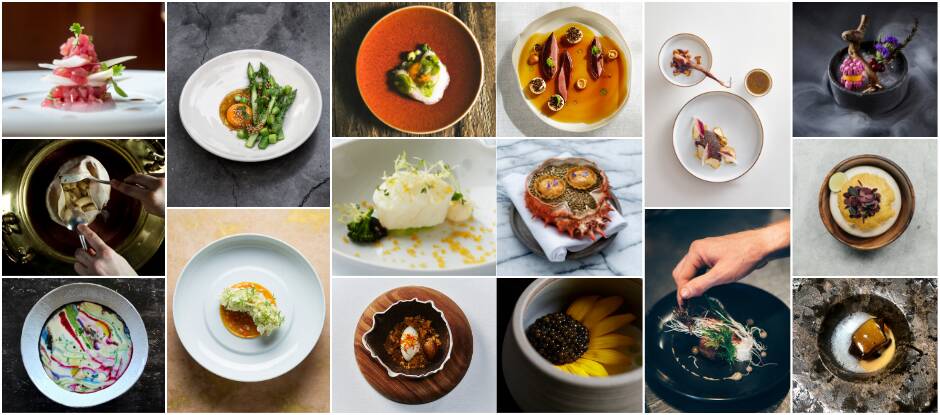The new list of The World’s 50 Best Restaurants 2019, sponsored by S.Pellegrino and Acqua Panna, has been announced, counting 12 new entries and three re-entries and featuring restaurants from 37 cities across 26 countries. We count down all of the spots voted into this edition while exploring each restaurant’s signature dish.
No.50 Schloss Schauenstein, Fürstenau, Switzerland – Swiss pikeperch with fennel and lemon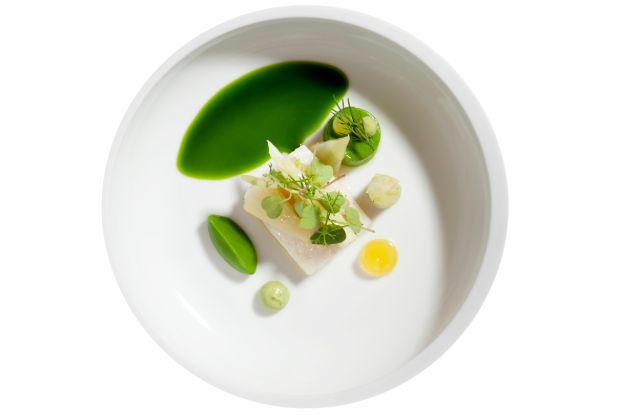
Housed in a fairy tale castle in the Swiss Alps, Andreas Caminada’s bastion of precise cookery is built on local produce. For the signature pikeperch dish, the Schloss Schauenstein team works exclusively with Swiss producers – it is only available when trusted fisherman Hans-Peter, who gets his produce from the Walensee Lake 20 minutes from the restaurant, catches the pikeperches. The fish fillets are served with a tarragon and onion cream and combined with a variety of fennels in different textures. The fennel gives the dish a fresh herbal touch and delicate fruitiness, mixed with the flavours of lime, yuzu and Kalamansi.
NEW ENTRY
No.49 Leo, Bogotá, Colombia – Ciclo Bioma
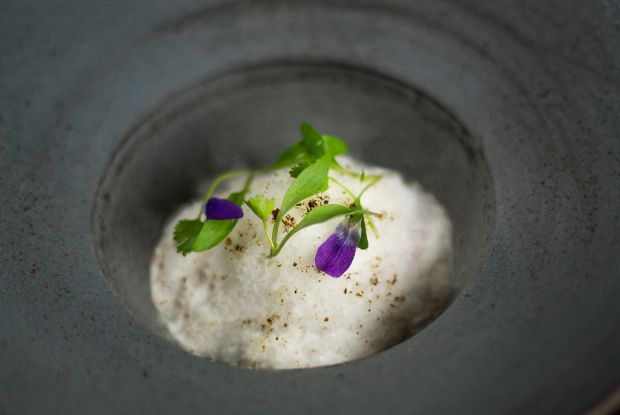
Leonor Espinosa’s restaurant in the Colombian capital is an ode to indigenous produce from all over the country. The restaurant doesn’t have a signature dish, preferring instead to say that it has a ‘signature menu’ – it is called Ciclo Bioma and it focuses on Colombian ecosystems, exploring the ways in which new species can be used in the kitchen. Among the representative dishes is the pirarucú (an Amazonian fish) with cacay plant, bitter cassava and ají lulito fruit, an exploration of the produce of the Amazonian forest.
No.48 Ultraviolet by Paul Pairet, Shanghai, China – Tomato mozza and again
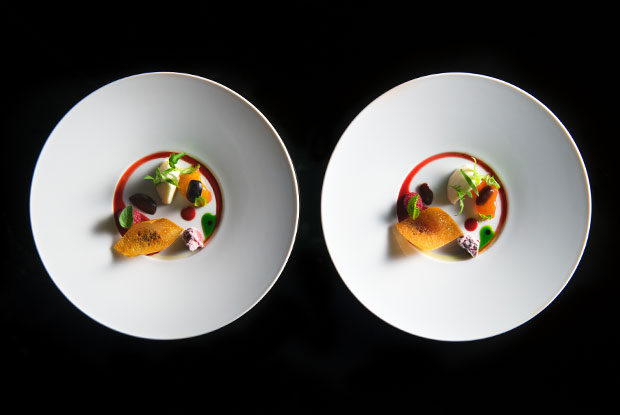
Super-secret, ultra-immersive and multi-sensory, this Shanghai restaurant will challenge your senses and your idea of what food is. Paul Pairet’s signature dish is presented in two plates that, at first glance, look identical – however, while one is a real tomato and mozzarella salad, the other is made up of sweet elements and preparations carefully designed to resemble the original savoury recipe. Playing with your taste expectations, the dish is served within Ultraviolet’s custom-built dining room to images of the famous food-inspired ‘composite heads’ painted by Italian artist Giuseppe Arcimboldo – although the images look the same, they also feature subtle differences.
NEW ENTRY
No.47 Benu, San Francisco, USA – Barbecued quail, seasonal condiments and steamed bun
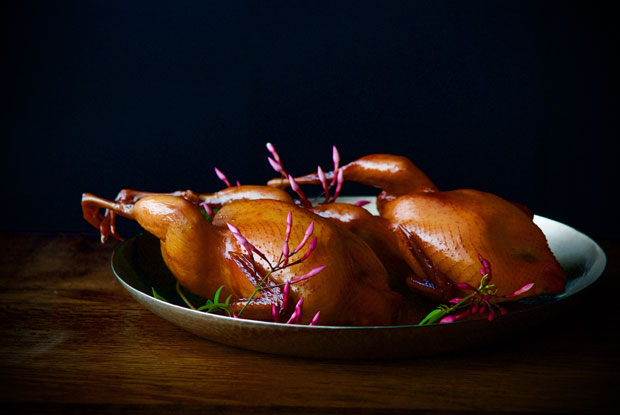
Corey Lee’s sensory tasting menu is a journey through transnational culinary traditions, from American to Korean and Cantonese. For his signature dish, Lee sources the quails from Wolfe Ranch, a farm the chef has been working with for over 20 years. The bird is marinated, smoked, roasted and finally splashed with hot oil before it’s carved. “The flavour of the skin and the caramelised marinade is reminiscent of Cantonese barbecued poultry, but a notable difference is that the meat is served pink and still very juicy,” says the Benu team. The quail is served with seasonal garnishes that change throughout the year.
RE-ENTRY
No.46 De Librije, Zwolle, The Netherlands – Crayfish, gagel and foie gras
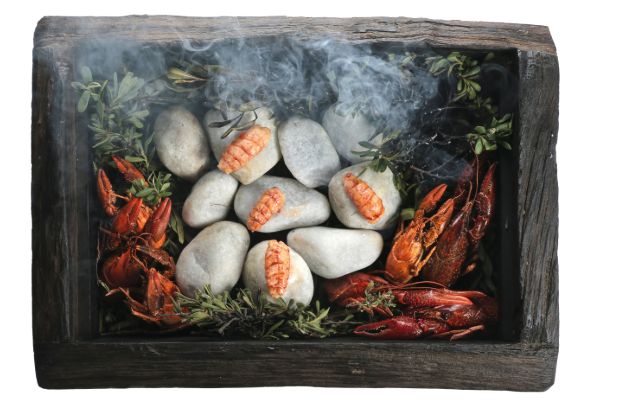
The menu at this influential Dutch restaurant is tailored to suit individual tastes – guests choose their preferred combination of seasonal ingredients, then plates are added to create bespoke tasting menus. Representative of Jonnie Boer’s cuisine is the dish with crayfish, gagel (the Dutch word for a sweet gale bush) and foie gras. The crayfish is presented in a closed box lying on the gagel, which is dramatically lit. The fish is smoked at the table for three to four minutes and served with foie gras and pickled berries. Only at this point the lid is removed from the box for the theatrical presentation of the crayfish.
NEW ENTRY
No.45 Sühring, Bangkok, Thailand – Labskaus, pickled rolled herring and fried egg
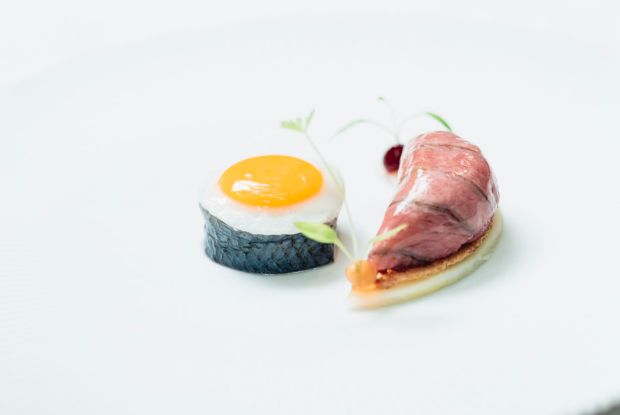
Twin brothers Mathias and Thomas Sühring’s German cuisine outpost in Bangkok is as unexpected as it is delicious. From their seasonal and sophisticated menu, they picked the Labskaus as their signature dish. “Labskaus is a culinary speciality from northern Germany,” they explain. “The dish was first mentioned in 1706 and was popular among sailors and seamen, and it still exists today.” Traditionally, it is made with salted meat, potatoes, onion, beetroot, fried egg, pickled gherkin and herring. “For our version, we present the Labskaus wrapped in a slice of roasted beef and serve it with Rollmops [pickled herring fillets] and a fried quail egg. It is a fantastic dish with fine earthy notes of beetroot and potatoes, rich and salted beef combined with the sour cucumber and herring, and a creamy yolk.”
No.44 The Test Kitchen, Cape Town, South Africa – Billionaire Porcini Shortbread

Voted The Best Restaurant in Africa 2019, this creative restaurant by Luke Dale-Roberts serves inventive interpretations of popular global dishes with a South African twist. Its Billionaire Shortbread is a savoury take on the classic millionaire. “The layers consist of a porcini shortbread base topped with a truffle jelly that is sandwiched together with a rich and smooth duck liver parfait,” says The Test Kitchen’s team. “We spread a thin layer of 99% dark chocolate on top, and once it is set, we finish the billionaire off with a 24ct gold leaf.” The billionaire is the first course at The Test Kitchen, while the final course is a millionaire shortbread.
RE-ENTRY
No.43 Hof Van Cleve, Kruisem, Belgium – Eel from the Oosterschelde
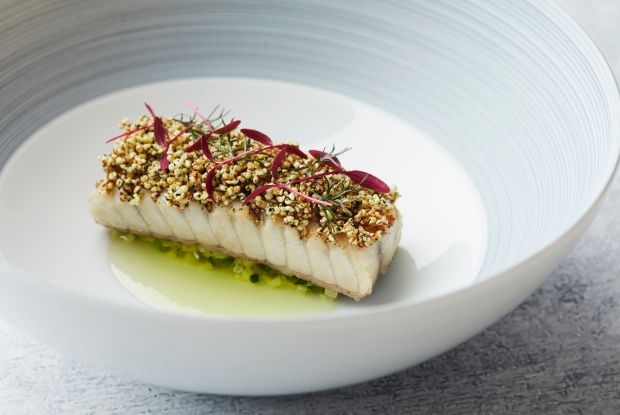
A gastronomic destination set in bucolic East Flanders, Hof Van Cleve started as a working farm before Peter Goossens elevated it to the culinary great it is now. At the heart of the chef's signature dish is the eel, a regional variety that the Hof Van Cleve team sources from Oosterschelde. “The ell is ready cooked at a low temperature in order to preserve the soft and fat texture. After this, it is grilled with baked zucchini and a cream of zucchini and puffed amaranth. We serve it alongside a clear fennel soup consommé with wakame oil,” explains Goossens. “The more common dish of stewed eel in chervil sauce is still tremendously appreciated in Flanders. That’s why we’ve made this gastronomic variant of eel one of our signature dishes.”
NEW ENTRY
No.42 Belcanto, Lisbon, Portugal – Seabass with avocado and dashi
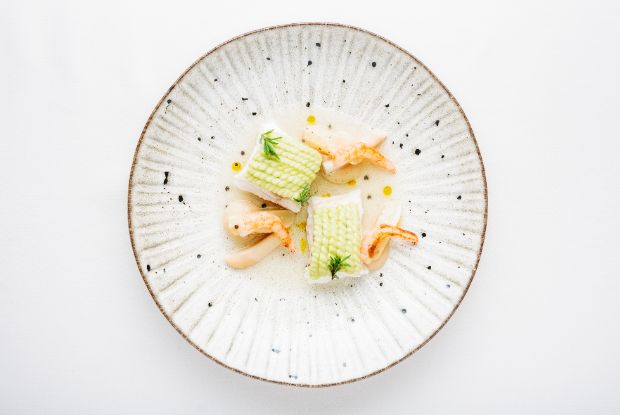
Since José Avillez took over Belcanto in 2012, the restaurant has gone from strength to strength. Making use of the best fresh produce from Portugal’s coastline, Belcanto specialises in seafood, as exemplified by their signature seabass with avocado and dashi. The sea bass loins are steeped in brine, then cooked sous-vide in their own juices, allowing them to retain all moisture and flavour. Thanks to its rich and fat texture, the avocado is used to mimic the seabass skin. It is mashed, seasoned and cold-smoked – the smokiness is designed to evoke the grilled flavour. The fish is served with dashi, steam-cooked coastal prawns and razor clams, salsify, and finished with lime zest and pistachio oil.
NEW ENTRY
No.41 The Chairman, Hong Kong, China – Steamed fresh flower crab with aged Chinese wine
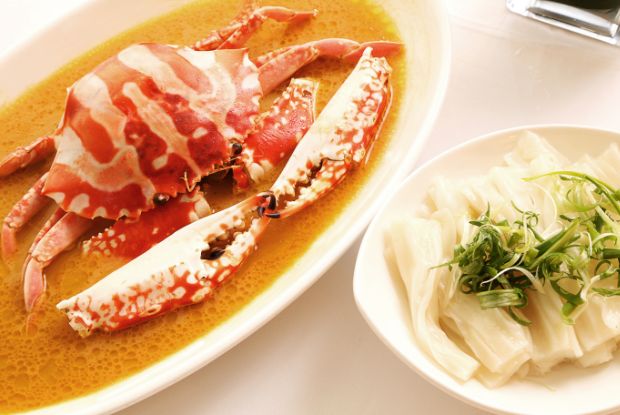
Chef Kwok Keung Tung’s produce-driven and seasonal Cantonese cookery stands out among Hong Kong’s concentration of excellent Chinese kitchens. Owner Danny Yip is known to suggest the flower crab as an entrée to first-time customers, but this is a dish that many also return for. The flower crab is a prized delicacy from the South China Sea, renowned for its sweet taste. In The Chairman’s recipe, it is steamed with 15-year-old Chinese wine, chicken fat and claim juice, and served alongside fragrant chicken oil and flat rice noodles.
No.40 Restaurant Tim Raue, Berlin, Germany – Salmon, tomato and anise
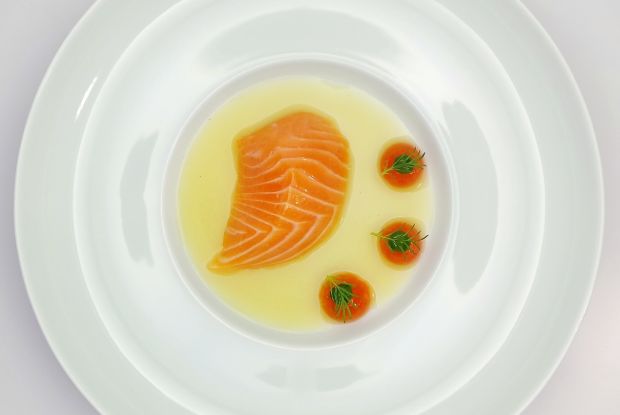
Inspired by Asian cuisine after travelling around the continent as a young cook, Tim Raue brought back inspiration and influences from Japan, Thailand and China and used them to open Restaurant Tim Raue in Berlin in 2010, where he serves his unique style of German-Asian fusion. Raue’s signature dish features salmon, tomato and anise. The salmon is lightly poached in orange zest-flavoured butter, while the tomato is served as a clear juice, flavoured with star-anise, rice vinegar and red Thai chili. Finally, the tomato salad is presented in ball shape, flavoured with green jalapeño chili and topped with a cream of green anise.
NEW ENTRY
No.39 A Casa Do Porco, São Paulo, Brazil – Porco San Zé
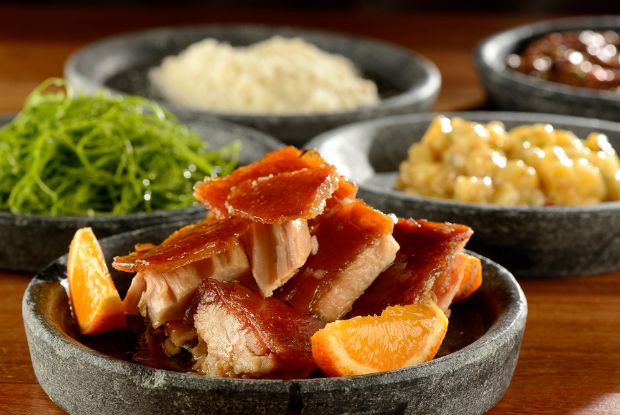
This new entry to the list in the heart of São Paulo serves pork in every form imaginable. Chef Jefferson Rueda is extremely demanding with the meat he uses, rearing his pigs on a natural diet of whey and vegetables and slaughtering them in his own slaughterhouse for ultimate control. Every part of the animal is used in his kitchen – his signature dish, Porco San Zé, features pork roasted for six hours on the grill and served with a bean purée, banana tartar, onion farofa, kale or pumpkin quibebe and almond salad.
No.38 Hiša Franko, Kobarid, Slovenia – Trout, whey and poppy seed

Self-taught cook Ana Roš is an expert in taking the best produce from the surrounding Soča Valley in Slovenia and transforming it into intricate dishes that give prominence to local ingredients, some of which may only be available for a few days a year. For the signature trout dish, the Hiša Franko team sources the fish from the stream that runs beside the restaurant. “We fish it every evening before the service. We tend to use the whole fish – belly, files, pins and liver. This dish is a symbol for what one day was Austro-Hungarian empire,” they say. The trout is served with whey, poppy seeds, beetroot, a salad of Fallopia Japonica, sorrel and wild watercress.
No.37 Alinea, Chicago, USA – Paint: collaboration with Thomas Masters
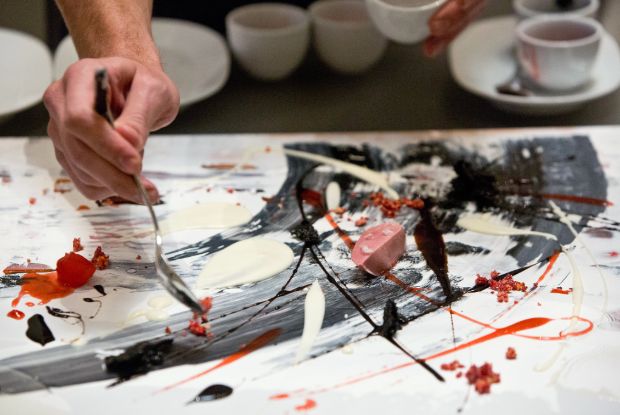
At the forefront of modern creativity since its debut in 2005, Alinea always finds ways to reinvent itself and push the boundaries of what food is. Chef Grant Achatz has been collaborating with Chicago artist Thomas Masters for his latest signature dish. Featuring duck, huitlacoche, strawberry and white corn, the dish is served on an acrylic art piece. During the meal, Thomas Masters’ paintings are unhooked from the restaurant’s ceiling and walls and presented to the guests at the table. The ingredients are then plated over the art, creating a connection between the colours of the paintings and the ingredients.
No.36 Le Bernardin, New York, USA – Crab
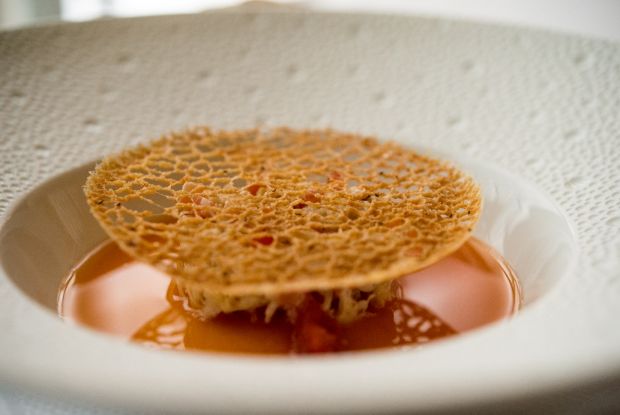
Established in Paris nearly 50 years ago by Gilbert and Maguy Le Coze, Le Bernardin expanded to New York in 1986. For over 20 years, homegrown talent Eric Ripert has been running the kitchen, creating a fish-forward menu of dishes marrying French and global influences. The signature crab dish consists of steamed Dungeness crab mixed with Italian black rice, green mango and crab chili paste to make a sort of ‘crab cake’, topped with a crisp tuile and finished with a crab Vadouvan sweet curry sauce poured tableside. It is served with a mango and papaya salad.
NEW ENTRY
No.35 Atelier Crenn, San Francisco, USA – Geoduck tart
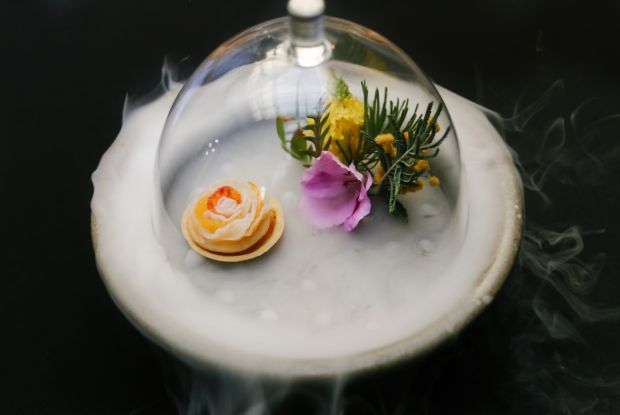
A serene escape from San Francisco, Atelier Crenn is the playground of chef Dominique Crenn, who created her own style of cuisine – Poetic Culinaria – where every dish is accompanied by the cook’s own poems explaining the sensations that they evoke. Among the signatures on the light and balanced tasting menu is the geoduck tart, a Koshihikari rice tart with local sea urchin, poached in brown butter with geoduck from the nearby coast. It is cooked with Sonoma citrus and topped with a citrus, lemongrass and lemon verbena mousseline.
NEW ENTRY
No.34 Don Julio, Buenos Aires, Argentina – Skirt steak
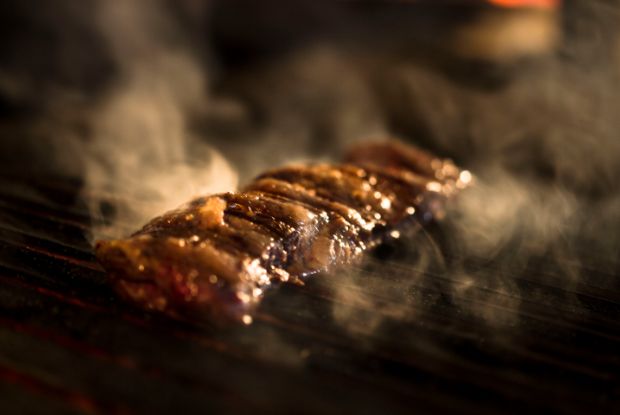
This traditional Argentine parrilla revolves around its traditional “V” iron grill, which almost every ingredient touches. “The skirt steak (entraña) is a long, flat cut of beef prized for its flavour,” says owner Pablo Rivero. “This is a great representation of our gastronomy, because it is simple and tasty – you only need a little bit of salt and fire. Like all our cuts, the skirt steak comes only from Aberdeen Angus and Hereford beef. In order to emphasize its natural features, we carry out a maturation process in our own cold storage, taking into account the properties of each cut.”
No.33 Lyle’s, London, UK – Peas and Ticklemore

James Lowe’s restaurant in a trendy London neighbourhood serves micro-seasonal daily menus showcasing the best produce in London and the UK. Lowe’s take on British cuisine focuses on working with the right producers to source the best ingredients in the country. For his signature dish of peas and Ticklemore cheese, Lowe says that it’s supremely important to pick the peas at their freshest, so they will be sweet and crunchy. They are served with mint leaves, a dressing made of olive oil, apple juice and cider vinegar, and a chervil salt. The peas are spread on a thin layer and covered with thinly sliced Ticklemore, then served with the pea shoots, wild peas flowers and pickled chervil leaves.
NEW ENTRY
No.32 Nerua, Bilbao, Spain – Hake kokotxa, white asparagus and egg

Every year, Josean Alija changes Nerua’s menu three times – in spring, summer and fall/winter. Working side by side with local producers to guarantee the maximum freshness and quality of the products, his cuisine is a manifestation of his identity as Basque – a land known for its incredible produce from rivers, sea and farms. Alija serves different version of the kokotxas – the fish throats considered a delicacy in Basque cuisine – throughout the year. In this version, the cheeks are served with white asparagus and egg, a reinterpretation of a traditional Basque recipe.
No.31 Le Calandre, Rubano, Italy – Cappuccino Murrina
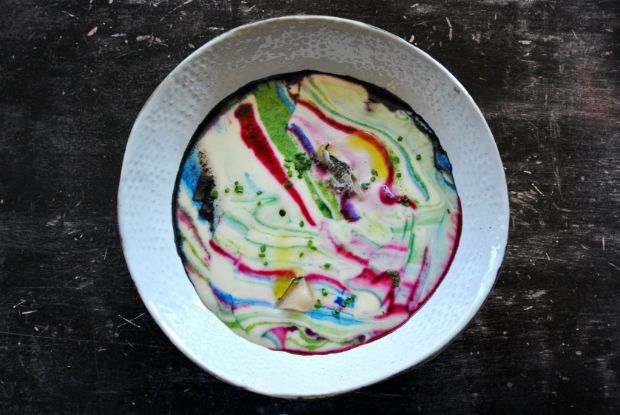
Brothers Massimiliano and Raffaele Alajmo are at the helm of a restaurant that has been voted in over 10 editions of The World’s 50 Best Restaurants list. With his deceptively simple but painstakingly curated dishes, Massimiliano is the mind behind the flavours, while Raffaele is the smile in the dining room. The chef’s signature dish Cappuccino Murrina is an evolution of his Cuttlefish Cappuccino, now featuring a light potato cream topped with Venetian seafood and a kaleidoscope of natural colours, a tribute to Venetian Murrina glasswork.
NEW ENTRY
No.30 Elkano, Getaria, Spain – Grilled turbot
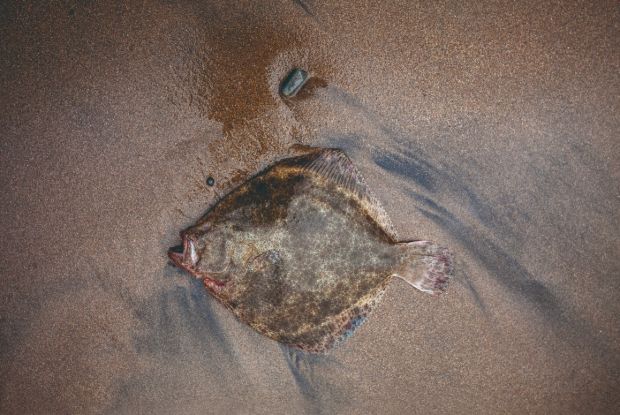
The Arregui family are the Basque Country’s historical innovators of the art of grilling. Current chef Aitor inherited Elkano from his late father Pedro Arregui, who was the first to revolutionise the way the turbot is cooked. The Arreguis chargrill the whole turbot – which can weight up to two kilos – without removing the skin, which becomes a protective film for the gelatinous fillets during cooking. The fish is served simply at the table with a vinaigrette whose recipe still remains a guarded family secret. Arregui knows exactly how to extract the best flavour from each part of the turbot, instructing diners to eat it with their hands – like fishermen used to do – for the best tasting experience.
No.29 Piazza Duomo, Alba, Italy – Salad 21...31...41...51...
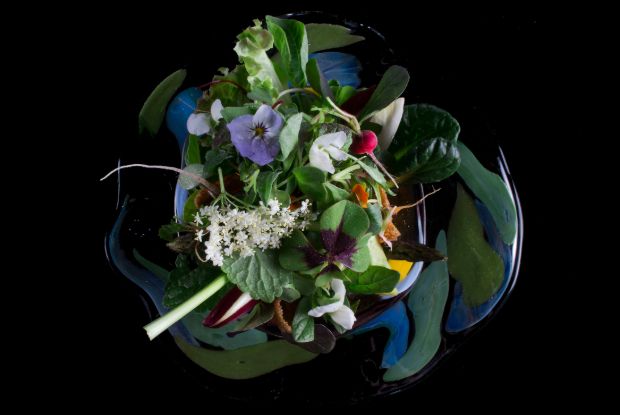
Piazza Duomo gives guests a taste of Piedmont, one of the finest food and wine regions in the world. Led by chef Enrico Crippa, the kitchen produces a series of creative bites and plates that take diners on a journey of the region and of Italy. At the heart of the restaurant is its vegetable garden, from which come the leaves, herbs and vegetables that form the signature dish Salad 21…31…41…51… The number and make up of the ingredients vary according to the season, but the salad can count from 50 to as many as 120 ingredients, all grown at the restaurant.
No.28 Blue Hill at Stone Barns, Pocantico Hills, USA – Tetra squash stem penne in the style of cacio e pepe

At Dan Barber’s farmstead restaurant, set within an enchanting barn 30 miles north of Manhattan, the chef serves a tasting menu centred on produce. In order to develop more nutritious fruit and more flavoursome vegetables, Barber has been working with seed breeders at the genetic level. “These tetra squashes are a new breed of squash we helped develop with Cornell University breeder Michael Mazourek,” says the Blue Hill team. “The idea was to create a multi-purpose squash – an entire plant that is not only edible, but delicious. Since the stems are so much sweeter and less fibrous, we turn them into a vegetarian pasta.” The squash stem pasta is served in the style of cacio e pepe, like in the traditional Italian recipe.
No.27 The Clove Club, London, UK – Raw Orkney scallop, hazelnut, clementine and Périgord truffle
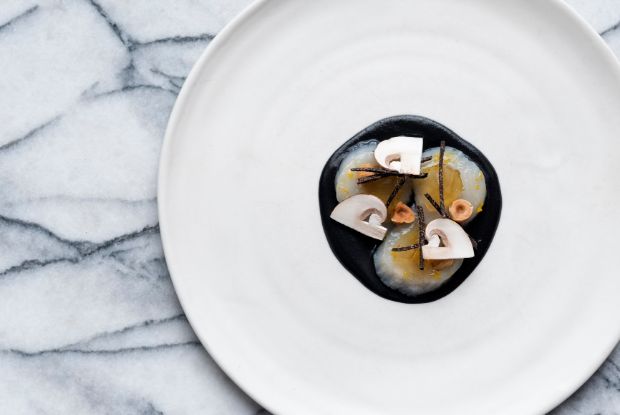
The Clove Club’s interpretation of ‘modern British’ is refreshing and full of surprises, with fresh produce from all over the UK reinvented in creations that put forward natural flavours and playfully mingle with tradition. Set within the historic Shoreditch Town Hall, the blue-tiled dining room has a relaxed East London vibe with an open kitchen and laid-back service. Scottish chef Isaac McHale is the mind behind the restaurant’s signature, a dish of raw Orkney scallop (from the eponymous archipelago north of Scotland) served with earthy truffle, sweet hazelnut and a piercing clementine jelly.
No.26 Boragó, Santiago, Chile – Roasted flowers “À la Van Gogh”
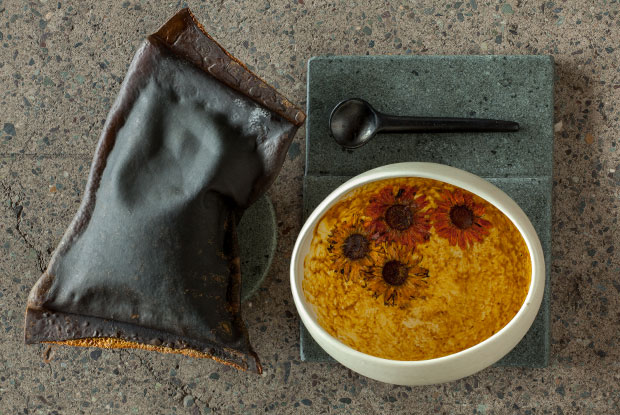
Recently relocated to a bigger home alongside a new food research centre, Boragó is also proposing a series of new dishes. Chef Rodolfo Guzmán has travelled all the latitudes of Chile discovering new products to use at the restaurant – for this signature dish, he chose flowers. “We are treating these meaty flowers on top of the embers and then roasting them,” explains Guzmán. “We dress the flowers à la minute with some juices of ‘well treated Loyo’, a mushroom that only grows one month a year, and with some secret condiments. On the side, you find mushrooms cooked inside of a bladder of seaweed with herbs and Chilean mandarins.”
No.25 Alléno Paris au Pavillon Ledoyen, Paris, France – Milk-fed calf aged with blackcurrant milk
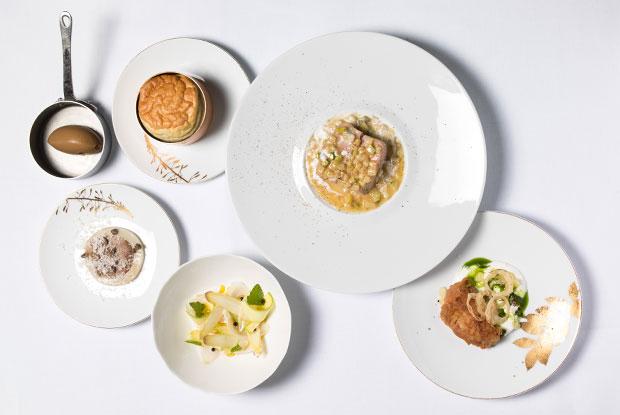
Yannick Alléno’s arrival at the helm of Pavillon Ledoyen in 2014 marked a new chapter for the restaurant, with his extravagant dishes telling a vibrant tale of modern French cuisine. Technique, originality and an obsession with flavour are the cornerstones of his work. For his signature calf dish, the chef only uses milk-fed animals from French farms, which he ages in blackcurrant milk. The elaborate dish also includes sweetbreads with burrata cheese and parsley juice; veal’s head with capers from Safi and raw vegetables with a film of frozen soufflé and balsamic vinegar; and a veal chop with raw and cooked porcini mushrooms flavoured with nutmeg.
No.24 Quintonil, Mexico City, Mexico – Dry-aged pork in chile pasado

Many of the ingredients in Jorge Vallejo’s fresh and authentic Mexican cuisine come from a nearby garden, where the cook picks fresh veg and greens on a daily basis. Quintonil’s signature dry-aged pork dish has its origin in a family recipe that one of restaurant’s cooks brought with him from Chihuahua in north-west Mexico. “It is a contemporary version of a rural recipe based on Californian and Poblano chilis, potatoes and potato cream with grilled cheese and baked pork,” says the Quintonil team. The chilis are roasted, peeled, seeded and dried to form a paste, called chile pasado, which is served with the meat. The dish is finished with plums and figs infused in chili tea.
No.23 Cosme, New York, USA – Snow crab infladita
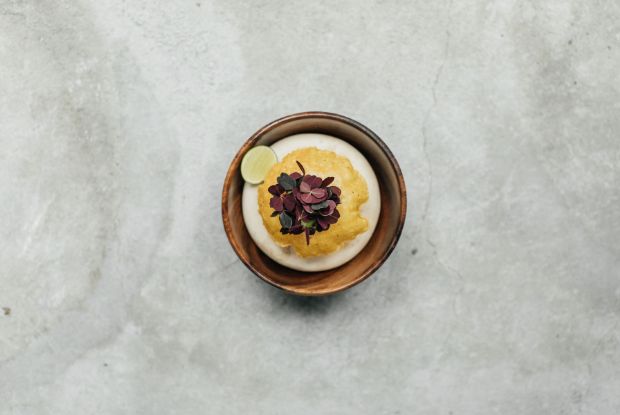
The World’s Best Female Chef 2019, Daniela Soto-Innes, serves original Mexican cuisine in the heart of Manhattan. Famous for running a relaxed kitchen with music, dancing and pre-service warm-up exercises, she is the author of original dishes that reflect her inclusive philosophy. Soto-Innes describes the infladita as the “beautiful mistake” that happens when a tortilla inflates when frying. In her version, the infladita is served with delicious snow crab, morita chilis and avocado.
No.22 Narisawa, Tokyo, Japan – Satoyama Scenery
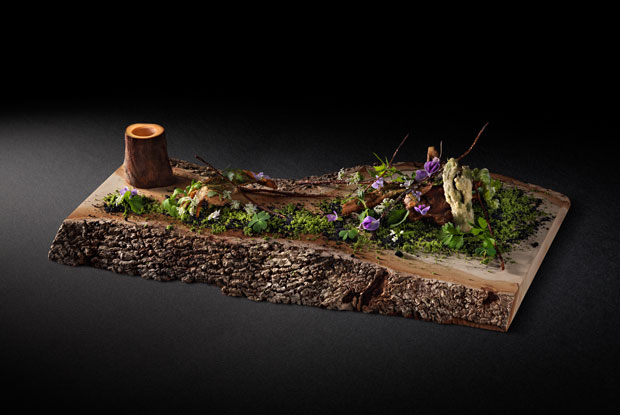
“I take inspiration from everything in nature, from scenery to wind, the temperature I feel on my skin, the scent of the air, the plants and the soil, the sound of the stream, the trees and the flavours of edible plants,” says chef Yoshihiro Narisawa. He defines his cuisine at the eponymous iconic Tokyo restaurant as Innovative Satoyama, “sato” meaning village or community and “yama” meaning forest in Japanese. His signature appetizer, Satoyama Scenery, is an edible landscape made of ingredients from Shirakami Sanchi, a UNESCO heritage rainforest in the Aomori Prefecture, perfectly exemplifying the chef’s philosophy.
RE-ENTRY
No.21 Frantzén, Stockholm, Sweden – French toast
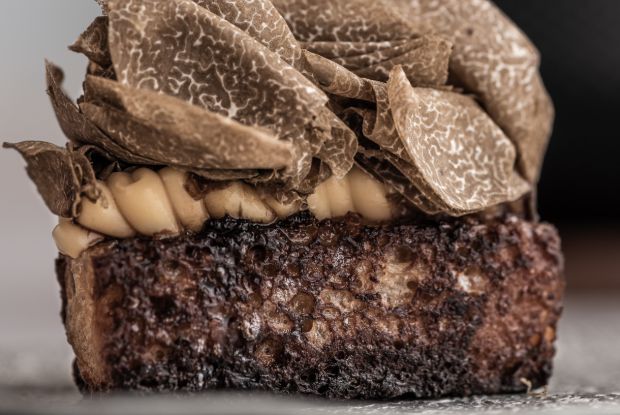
From humble origins as a bijou dining room in Stockholm’s old town, Frantzén shut up shop in 2016 to relocate to larger premises, and it is now back with a bang. Each sitting sees 23 guests traverse the rooms and floors of the building as they make their way through an experiential 10-course menu. Bjorn Frantzén’s new signature is the French Toast, with uni, truffle and grilled bone broth à la truffle on cubes of caramelised sourdough bread.
No.20 Tickets, Barcelona, Spain – Green “peas-sion” fruit
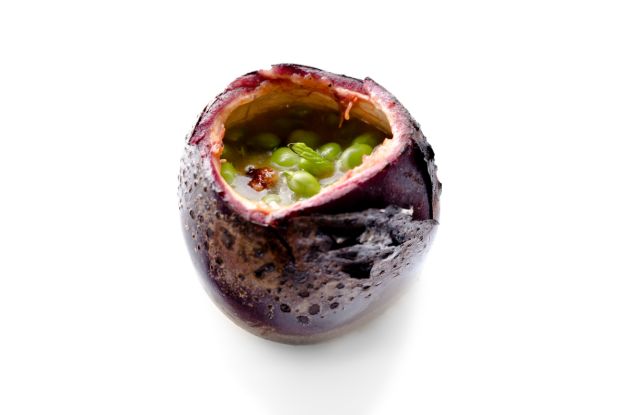
Albert Adrià’s playhouse of culinary fun takes tapas to the cutting edge. The restaurant is housed in a circus-themed space, with five small plate bars and open kitchens surrounding the perimeter of the restaurant. Adrià and his team’s cuisine is trailblazing, with progressive dishes that surprise and delight. The green “peas-sion” fruit is a fun-filled creation featuring chargrilled Maresme green peas, roasted chicken jus and passion fruit.
NEW ENTRY
No.19 Twins Garden, Moscow, Russia – Cabbage and carrot wine

Sourcing 70% of the produce from their own farm outside Moscow, identical brothers Ivan and Sergey Berezutskiy serve creative combinations of ultra-fresh ingredients in the new incarnation of their restaurant. For their signature cabbage and carrot wine, “We cover a piece of cabbage in beef wax and dry age it for two weeks, then bake it in the Russian oven and serve with concentrated vegetable stock,” explains the team. “The carrot wine is made with a traditional winemaking technology using carrot and burgundy yeast. As the last step, the wine is aged it in an oak barrel.” The full recipe includes home-grown cabbage, which is covered in beef fat and dry-aged for 21 days, served with the carrot wine.
No.18 Odette, Singapore – Kampot pepper-crusted pigeon

Julien Royer’s unashamedly fine dining restaurant inside the National Gallery Singapore serves a unique brand of Asian-inspired French cuisine. “This is a dish that represents our cooking really well. It is a pigeon crusted with a Cambodian pepper called Kampot pepper,” says Royer. “The pigeon is served in different ways – yakitori made with the heart; a very light and modern version of a parfait, made with the liver; then the breast is crusted with this beautiful, very fragrant, very long-lasting-in-your-mouth pepper from Kampot, Cambodia.”
No.17 Steirereck, Vienna, Austria – Char in beeswax with yellow pollen "caviar" and sour cream
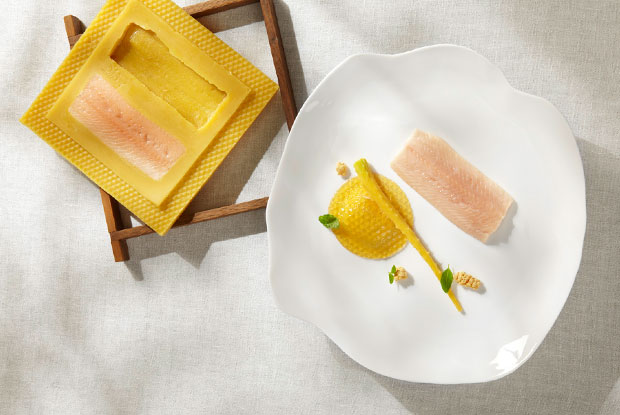
Steirereck’s menu leans heavily in favour of Austria’s rural Styrian region and its delicious but simple produce. The setting, however, is all but traditional: the restaurant is housed in a monolithic, architectural marvel of mirrored glass in Vienna’s Stadtpark. Chef Heinz Reitbauer’s signature is the char cooked in hot beeswax, served with cooked and marinated yellow carrot; beeswax-infused apple juice; sour cream spiced with cayenne pepper and lime; char caviar strewn with yellow carrot and a quince vinegar “pollen”; and basil cress.
No.16 Alain Ducasse au Plaza Athénée, Paris, France – Green lentils from Puy region and caviar
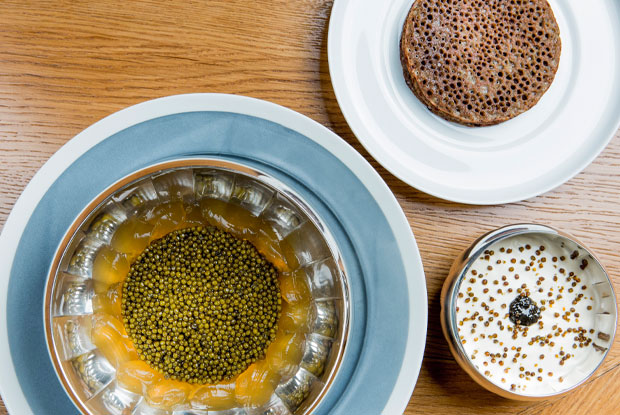
Alain Ducasse – one of the legendary leaders in classic French haute cuisine – prioritises sustainability, health and wellness-hinged plates focused on vegetables, fish and cereals. The restaurant’s luxurious and futuristic dining room is the setting for his naturalité style of cookery, aiming to extract the best natural flavours from the ingredients. For his signature recipe, the chef uses Schrenki sturgeon gold caviar raised in China and Pétrossian pressed caviar, served with green lentils from the Puy region, eel aspic, buckwheat and a lentil pancake.
No.15 Septime, Paris, France – Roasted endive, rye bread sauce and pickled mustard seeds
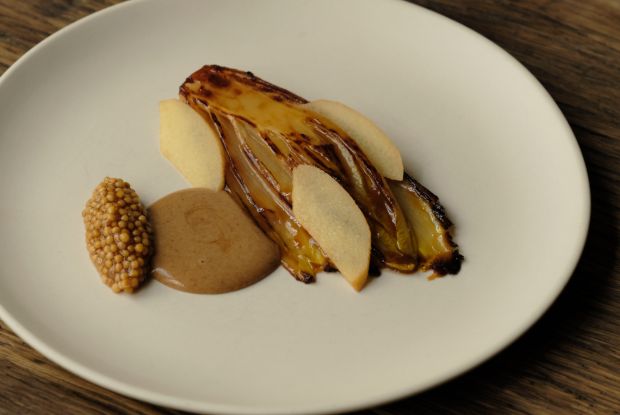
Chef Bertrand Grébaut’s seasonal, modern French plates have been luring in diners from around the world since the cosy restaurant opened eight years ago. One of the highlights at hyper-sustainable Septime is the roasted endive dish – the vegetables are slowly roasted with bone marrow and fresh herbs, and served with a rye bread sauce, pickled mustard seeds and salted, preserved quince apple.
No.14 Azurmendi, Larrabetzu, Spain – Shrimp, vegetable juice and frozen “old” tomato
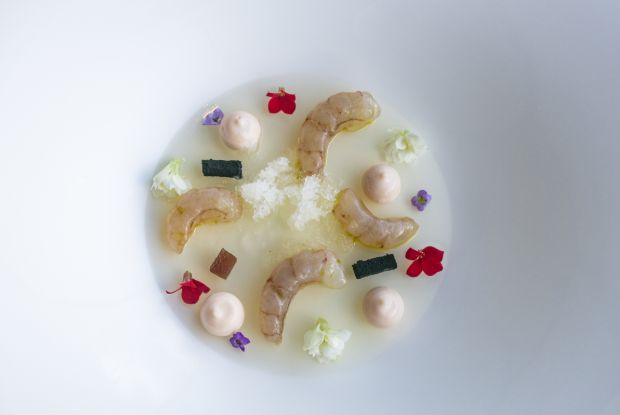
This year’s Westholme Highest Climber and the winner of the Sustainable Restaurant Award in 2014 and 2018, Azurmendi is set in an innovative building in the lush Basque countryside. “Our signature recipe is a dish that connects the sea with the land,” explains the Azurmendi team. “A vegetable such as the tomato connects with a marine product such as the shrimp. It is also a dish where the silky texture of the shrimp meets the seasonal local flowers. The tomato grenadine provides the freshness necessary to contrast the sweetness and temperance of the emulsion of olive oil and juice extracted from the shrimps' heads.”
No.13 White Rabbit, Moscow, Russia – Baked potatoes, sea urchin caviar and tangerines
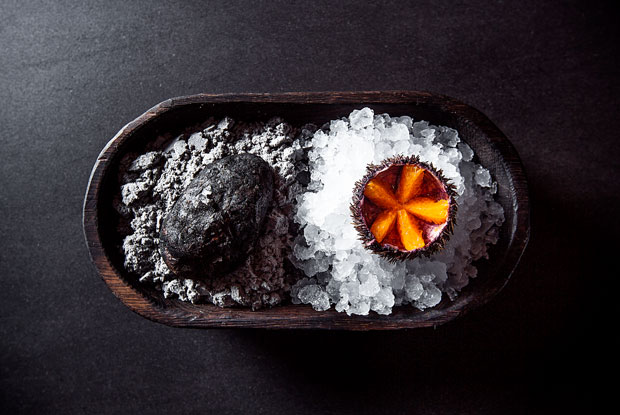
“The idea of the baked potatoes, sea urchin and tangerine dish is the contrast. Contrast is also the name of my latest tasting menu, because the whole menu is based on contrasts. One of the most important contrasts of present days is ice and fire – right after the famous Game of Thrones series. This dish represents ice and fire, but with a Russian twist,” explains chef Vladimir Mukhin of contemporary Russian restaurant White Rabbit. The potatoes are baked over fire, then filled with sea urchin caviar and a whipped sauce made of sweet Yalta onion. Contrasting the hot potato is a cold tangerine cut to look like sea urchin caviar and served in a sea urchin shell.
No.12 Pujol, Mexico City, Mexico – Mole madre, mole nuevo
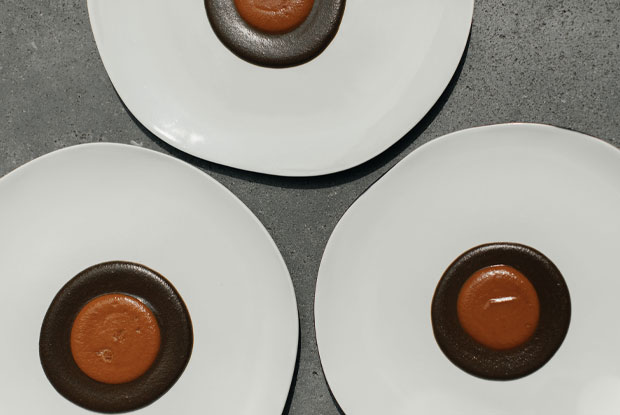
Celebrity chef Enrique Olvera is credited with proving that rustic Mexican flavours deserve as much attention as any other cuisine in the world. The restaurant relocated in 2017 to a stunning mid-century home with expansive windows, a wood oven, terrazzo floors and a long dining bar. Olvera’s signature consists of a perfect circle of fresh mole (a traditional Mexican sauce) surrounded by a larger ring of mole that has been aged for more than 1,500 days, beside a basket of warm tortillas – a taste of Mexico’s past.
No.11 Den, Tokyo, Japan – Monaka
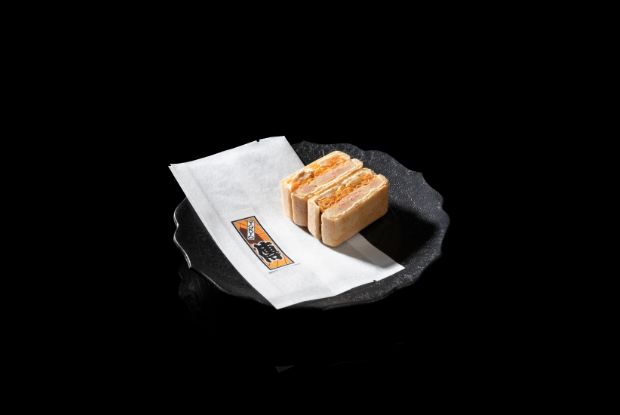
Chef Zaiyu Hasegawa offers an elevated, deeply personal take on Japanese home cooking, served with a side of service so warm and hospitable that it won him and his team the Art of Hospitality Award 2019, sponsored by Legle. In his cuisine he draws on diverse influences, both home-grown and gleaned on overseas trips, but always based around prime ingredients from ocean, pasture and forest. His signature appetiser Monaka is a wafer sandwich with miso-marinated foie gras, seasonal fruits and Japanese pickles.
No.10 Maido, Lima, Peru – 50-hour-cooked beef short rib
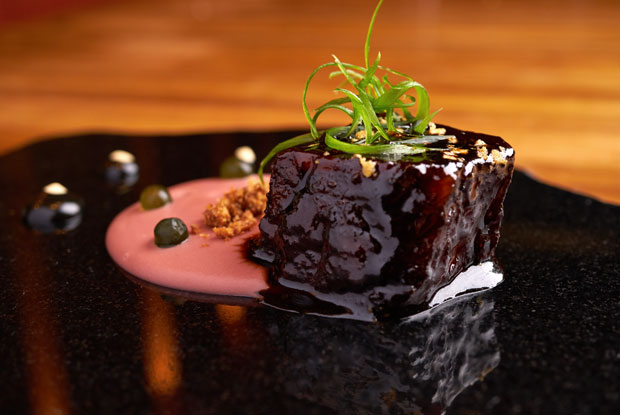
When Peru meets Japan on the plate, Nikkei is born – and chef Mitsuharu ‘Micha’ Tsumura is the Nikkei king. This translates to a welcoming spot where fresh fish and citrus-packed sauces reign supreme. Tsumura’s 50-hour-cooked beef short rib is now legendary – first, the meat is seared and cooked for over two days at 68° degrees sous-vide. It is served with a sauce made with dashi, mirin, sake, sugar, soy sauce, shiitake mushrooms, garlic, limo ají and beed stock, and finished with pickled strips of ginger called benishoga.
No.9 Disfrutar, Barcelona, Spain – Multi-spheric pesto with smoked eel
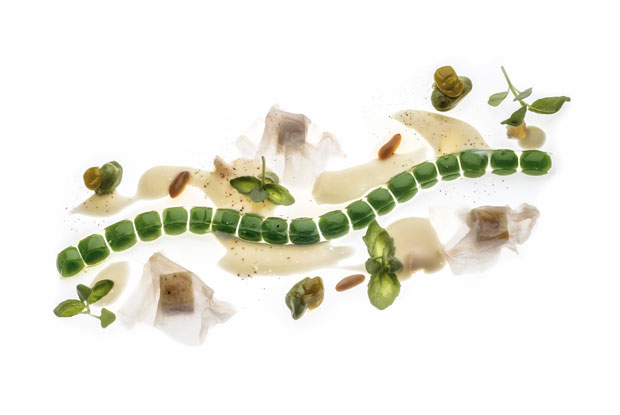
“This is one of our most iconic dishes – we’ve been doing it for about two and a half years now,” say chefs Mateu Casañas, Oriol Castro and Eduard Xatruch. “Through multi-spherification we manage, conceptually speaking, to turn the sauce into pasta. The pesto sauce earns an al dente pasta texture, but with the particularity that it is liquid inside. It is pasta and sauce at the same time.” At the trailblazing Barcelona restaurant led by the trio, the dish is accompanied with pistachios and traditional ingredients for pesto such pine nuts, Parmesan cheese and basil, plus a “smoked counterpoint” of smoked eel and cured bacon.
No.8 Arpège, Paris, France – Chimera lamb pigeon
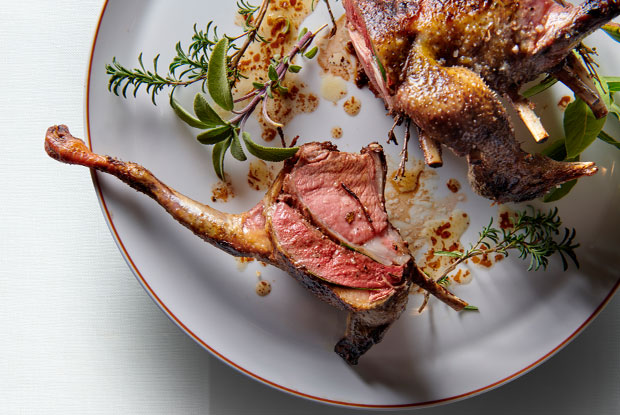
The winner of this year’s Chefs’ Choice Award, sponsored by Estrella Damm, chef Alain Passard is one of a handful of cooks who have remained at the top of global fine dining for decades. His Parisian restaurant Arpège has evolved over the years from an entirely vegetarian menu to one that now includes small quantities of meat and fish, drawing on inspiration from the world of art and sculpture. The signature Chimera lamb pigeon was inspired by Thomas Grundfeld’s art piece “Pigeon and Lamb misfit”, a sculpture that is half pigeon, half lamb – in the dish, the chef sows together a rack of lamb with a deboned pigeon.
No.7 Mugaritz, San Sebastián, Spain – Haiku flower kombucha
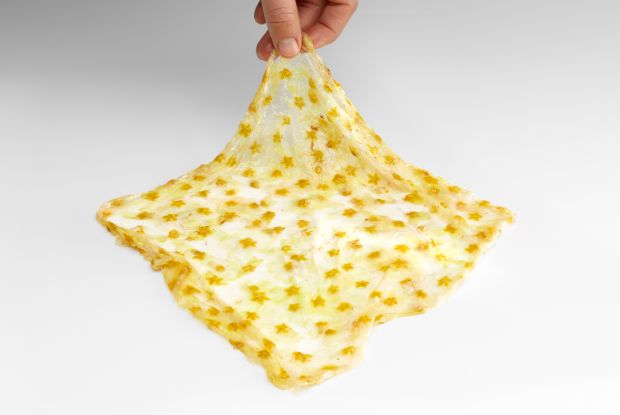
Mugaritz is a creative dining experience developed by Chef Andoni Luis Aduriz aimed to open minds. Set in a traditional Basque country house, complete with wooden beams and walls, the tasting menu takes you through a mind-blowing array of aromas, flavours, textures, temperatures and even sounds. The team describes their signature dish, the Haiku flower kombucha, as: “Following the tradition of capturing flowers, these captured flowers are floating on a kombucha mother laid off in a cold but sweet bath... natural landscape”. Expect the unexpected.
No.6 Central, Lima, Peru – Amazonian Waters
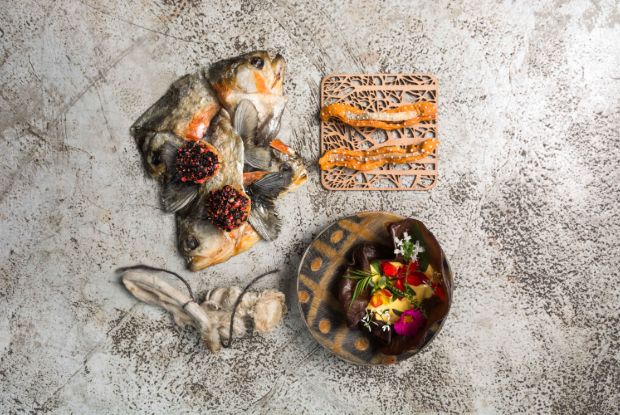
Chefs Virgilio Martínez and Pía León’s flagship restaurant is a shrine to everything that is Peruvian, including many ingredients that are seldom served elsewhere. Their passion for the country’s natural elements shines through in the signature recipe, which represents the ecosystem of an Amazonian lake. “The idea is to use the whole piranha,” says the Central team. “Heads, tails and bones are used as a plate. We use cassava and annato for the crisp, which is made with dehydrated skins. The flesh is used for the dumplings, which are topped with scales dyed with ungurahui, a natural black dye.” To finish it off, the sauce is made with cocona, a fruit from the Amazon, and the toppings are flowers and leaves from the jungle.
No.5 Geranium, Copenhagen, Denmark – "Marbled" hake, caviar and buttermilk
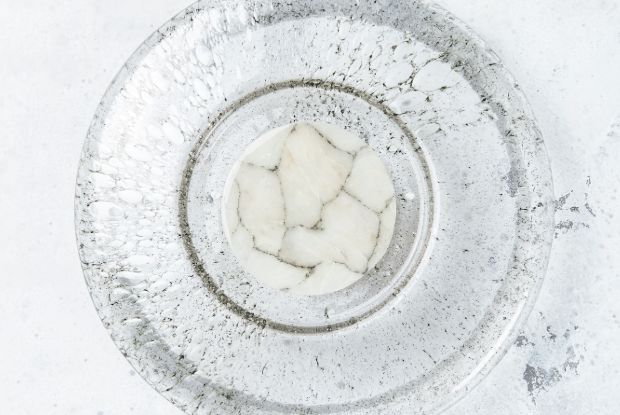
In the rather unexpected locale of a national soccer stadium, Geranium serves progressive tasting menus with artistic courses combining organic and wild Scandinavian ingredients. Last year’s winner of the Art of Hospitality Award is led by chef Rasmus Kofoed, the creator of the signature “marbled” hake. The marbling effect is created by rolling salted and lightly smoked hake with ash from burned parsley. The dish is finished with a rich sauce made of clarified buttermilk, parsley stems and a generous spoon of Oscietra caviar, and the crispy hake scales are finally added on top.
No.4 Gaggan, Bangkok, Thailand – Lick it up

Widely hailed as one of the best restaurants in Asia, Gaggan is an ever-evolving hub of creativity, and with the restaurant set to close in 2020, Indian chef Gaggan Anand has recently unveiled a new menu – which even features virtual reality – while planning his next opening with fellow chef Takeshi ‘Goh’ Fukuyama of La Maison de la Nature Goh. The idea of Lick it up, which is served to the eponymous song by Kiss, is that the flavours are spread on the plate according the different tasting areas of the tongue, and guests have to lick the plate to get the full experience – even including competitions for who did the best job.
No.3 Asador Etxebarri, Axpe, Spain – Grilled kokotxas

Chef Victor Arguinzoniz has a remarkable ability to coax out explosive flavour from seemingly simple ingredients, most of which are grilled over an open hearth. In this case, he unleashes his ability on the Basque delicacy known as kokotxas, or fish throats. Arguinzoniz grills the kokotxas while spreading them with a thin layer of flour, egg and olive oil mixture, which creates a film that prevents the fish from getting dry during cooking. The team highlights that the focus is not on the technique, but on the grill, which is at the heart of everything that is served at this outstanding Basque asador.
HIGHEST NEW ENTRY
No.2 Noma, Copenhagen, Denmark – Grilled smoked king crab
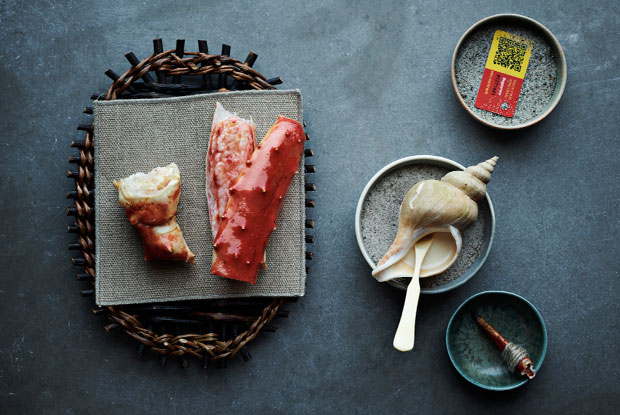
The new incarnation of Noma debuts on the list with a boom, entering at No.2 and winning the Highest New Entry Award. Chef René Redzepi has developed a new genre of cuisine over his career, with New Nordic cookery having become one of the most internationally celebrated cuisines in the world. For his new menu, Redzepi chose as his signature a dish of king crab from northern Norway. The crab leg is hot smoked and barbecued, then glazed with butter, seaweeds, mushroom and horseradish, and it is served with a sauce made from horseradish.
No.1 Mirazur, Menton, France – Green
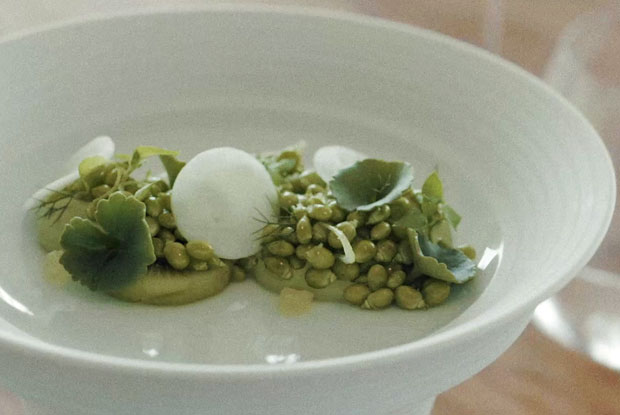
Mauro Colagreco’s product-driven take on Mediterranean cuisine, served to unrivalled views of the French Riviera, takes home the main accolade in 2019, becoming The World’s Best Restaurant, sponsored by S.Pellegrino & Acqua Panna. The chef sources much of his produce from the restaurant's three-tier gardens, where he also takes his young son Valentin for walks in the morning. Valentin likes to pick the fresh peas and eat them raw: Colagreco describes their flavour as "an explosion in the mouth". This is how he got the idea for his dish Green – although the menu changes every day to make use of the best daily produce, this simple but exceptional pea and kiwi dish is an outstanding example of the passionate cuisine that won the hearts of the gastronomic community across the world.
Now recap the whole list from No.50 to No.1 in the video:
The 2019 list of The World’s 50 Best Restaurants was announced on 25 June from Singapore. Browse the new list and follow us on Instagram, Facebook, Twitter and YouTube for all the news, features and updates.
